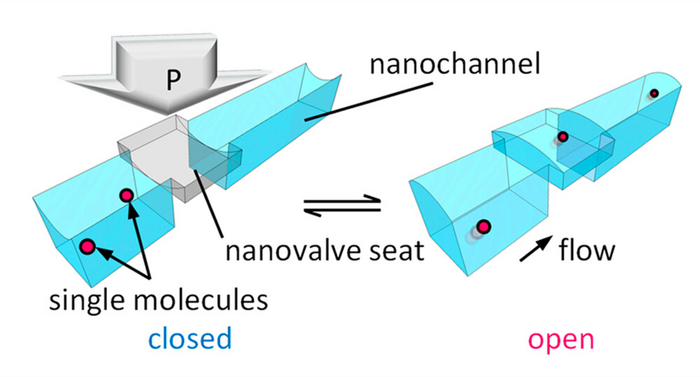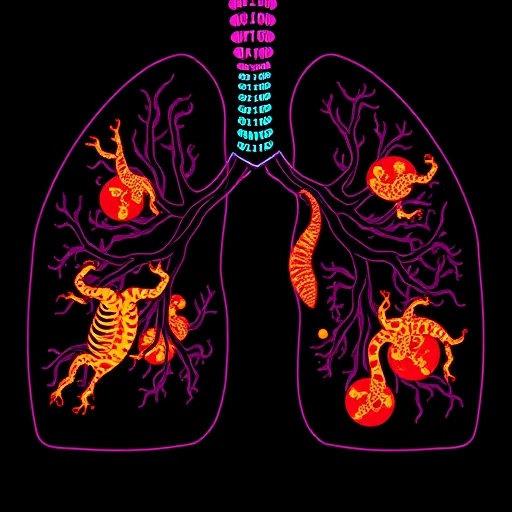Scientists dream of using tiny molecules as building blocks to construct things, similar to how we build things with mechanical parts. However, molecules are incredibly small – around one hundred millionth the size of a softball – and they move randomly in liquids, making it very difficult to manipulate them in a single form. To overcome this challenge, “nanofluidic devices” that can transport molecules in extremely narrow channels, similar in size to one millionth of a straw, are attracting attention as a way to directly manipulate single molecules in solutions.

Credit: Yan Xu, Osaka Metropolitan University
Scientists dream of using tiny molecules as building blocks to construct things, similar to how we build things with mechanical parts. However, molecules are incredibly small – around one hundred millionth the size of a softball – and they move randomly in liquids, making it very difficult to manipulate them in a single form. To overcome this challenge, “nanofluidic devices” that can transport molecules in extremely narrow channels, similar in size to one millionth of a straw, are attracting attention as a way to directly manipulate single molecules in solutions.
A joint research team led by Associate Professor Yan Xu of the Osaka Metropolitan University Graduate School of Engineering has succeeded in regulating the flow of single molecules in solution by opening and closing a nanovalve in a nanofluidic device by applying external pressure.
The research team fabricated a nanofluidic device with a thin, flexible glass sheet on the top, and a hard glass plate with small structures that forms nanochannels and nanovalve seats on the bottom. By applying external pressure to the flexible glass sheet to open and close the valve, they succeeded in directly manipulating and controlling the flow of individual molecules in solution. They also found that when they trapped single fluorescent molecules in the nanospace inside the valve, the fluorescence of the single molecules became brighter. This happened because the small space made it harder for the single molecules to move around randomly. Professor Xu said that “this effect of fluorescence signal amplification could help with detecting very small amounts of pathogens for early diagnosis of diseases such as cancers and Parkinson’s disease, without requiring expensive equipment.”
The findings of this study could be a significant step towards freely assembling materials using single molecules as building blocks in solution. This technology has the potential to be useful in various fields, such as developing personalized medicines for rare diseases and creating better displays and batteries. Its applications are limitless.
“We have been addressing various challenges by proposing and promoting the concept of ‘Single-Molecule Regulated Chemistry (SMRC),’ where molecules are treated as building blocks and all processes involved in chemical and biochemical reactions in solution are performed on a single-molecule basis. The single-molecule valve marks the first step towards the goal, which could one day revolutionize chemistry, biology, and materials science, as well as transform various industries,” said Professor Xu.
Their findings were published in Nano Letters.
Videos
- Single-molecule flow of Cy3 in a nanochannel https://youtu.be/p8IpoqEGfQ8
- Brownian motion of a single molecule (Cy3) confined in a valve nanospace https://youtube.com/shorts/Xs6X7V2kyBA
###
About OMU
Osaka Metropolitan University is the third largest public university in Japan, formed by a merger between Osaka City University and Osaka Prefecture University in 2022. OMU upholds “Convergence of Knowledge” through 11 undergraduate schools, a college, and 15 graduate schools. For more research news visit https://www.omu.ac.jp/en/ or follow us on Twitter: @OsakaMetUniv_en, or Facebook.
Journal
Nano Letters
DOI
10.1021/acs.nanolett.2c04807
Method of Research
Experimental study
Subject of Research
Not applicable
Article Title
Flexible glass-based hybrid nanofluidic device to enable the active regulation of single-molecule flows
Article Publication Date
6-Mar-2023
COI Statement
The authors declare no conflict of interest.




